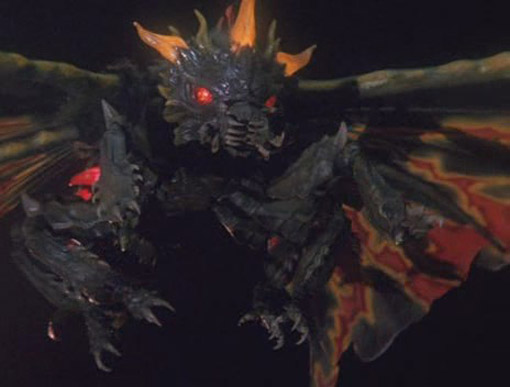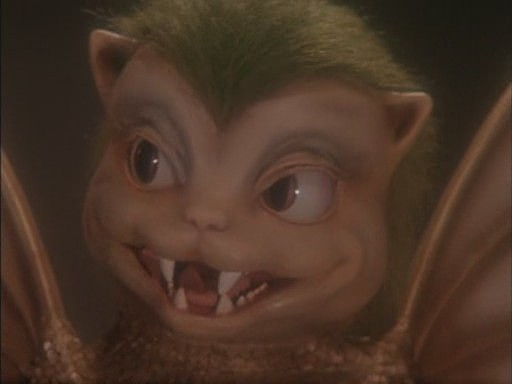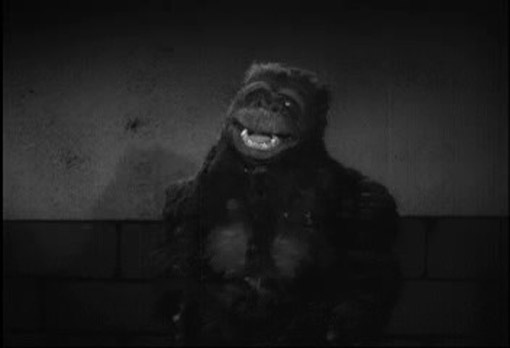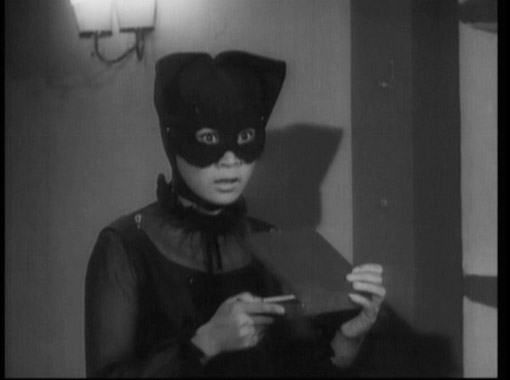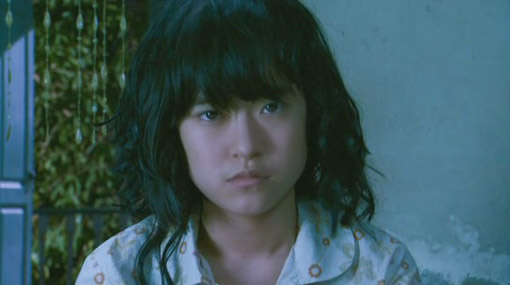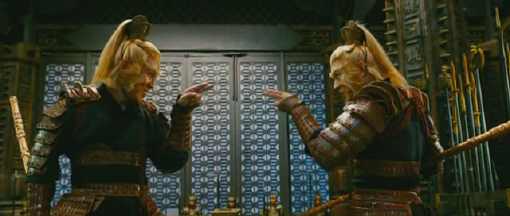
How the Ape Girl Stole the Lotus Lamp
aka 白猿女三盜寶蓮燈

1962 HKMDB Link DianYing Link
HKMDB Link DianYing Link
Directed and written by Wong Fung
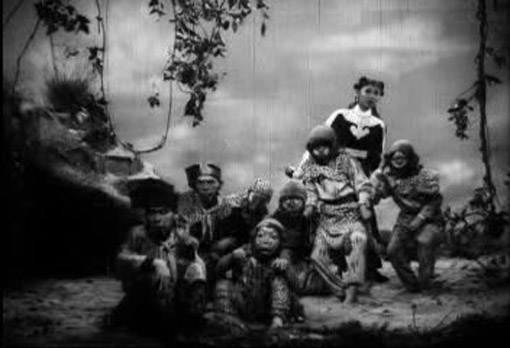
There is a lot of old Chinese cinema. Many films were made in the post-war period based on plays, operas, folk tales, and old novels. There was also a bunch of original content created. These old films have handpainted backgrounds, origins in operas and classical tales, and were produced quickly and cheaply. That doesn’t stop many of them from being interesting. I am fond of old-style effects, goofy plots, and stylized action as long as the film remains interesting. And in between all the older love/opera/drama type stories, there is a large pocket of wuxia/swordplay movies just waiting to be discovered. Although the audience for these films was large long ago, nowadays few people are even aware of them. Older Chinese people know of the films, but most of them don’t watch them regularly anymore, and even fewer have websites on the internet. So any specific film backgrounds I can find is few and far between (or in the case of this film, almost non-existent!) Heck, there is no IMDB entry for this film (no surprise there), and even the often reliable Hong Kong Movie Database has the wrong English name for the film.

Tribute is paid to these classic movies in the film Kung Fu vs. Acrobatic, which even co-stars Walter Tso Tat-Wah, one of the stars here and dozens of other classic films. How the Ape Girl Stole the Lotus Lamp is a lucky pick grabbed from a Chinatown movie store based solely on the pictures on the back of the VCD, which included some kids dressed up like monkeys. I am happy to report there are crazy monkey children in the film, but there are also lots of other cool retro effects. Even if I didn’t have my wife there to translate the film for me I would have been entertained (although slightly more confused.) The VCDs for these old films have no subtitles (why would they? I am one of the few non-native Cantonese speakers who would watch these) so the best to hope for is lots of fun stuff happening on the screen.

The VCD case makes the presence of Josephine Siao Fong-Fong well known, though at the time this movie was released (1962) she hadn’t taken off into super-stardom (where her major competitor would be the other, bigger 1960’s Cantonese sweetheart Connie Chan – seen here in Lady Black Cat) so Josephine has a supporting role in this film. Josephine Siao would later become a major leading lady, and participate in many of the Jane Bond films of the late 1960s and even do many films with her “rival” Connie Chan. She first appeared in 1954 and two years later won the Best Child Actor award for Orphan Girl. Like Connie Chan, she also had an impressive output in the 1960s, but in 1969 she slowed down her acting to focus on education and marriage (to actor Charlie Chin, which lasted three months – she later remarried and had children) She later appeared on TV as the bumbling plain Jane character Lam Ah Shun in 1977, followed by three films (one of them was Plain Jane to the Rescue, directed by a young John Woo). She is probably best known to fans from the 1990s for her parts as Fong Sai Yuk’s mother in the Fong Sai Yuk films. See the Jane Bond article for more of her films.

Sek Kin is another major Hong Kong actor making a supporting role here. Usually Sek Kin played villains and evil men in his movie roles. He was the ultimate Hong Kong villain character actor for decades. Oddly enough, although his character is a jerk in several scenes in How the Ape Girl Stole the Lotus Lamp, he isn’t the villain, and ends up doing some pretty noble things near the end. It was sort of weird seeing Sek Kin as a non-bad guy, I have only seen him in a few films but he was always over the top evil. Bruce Lee chose him as the villain in Enter the Dragon. At the time of this writing Sek Kin was still alive and kicking at age 95! He is also in Lady Black Cat where he plays a more common evil villain role.
Fitting with Chinese films, the cast is enormous, so here are the major players listed out (that way we can get shoutouts to all the more obscure Chinese actors and actresses that probably have next to nothing written about them in English.)

 |
Mo Kwun-tin (Walter Tso Tat-wah) – Strong fighter and student of the White-haired Nun, Mo Kwun-tin defends people being harassed and wants to marry Wong Kam-fung. His heroic nature gets him into trouble. Walter Tso Tat-wah began as extra and then a director in the beginnings of the Hong Kong film industry. He soon starred in front of the camera, and by 1941 he had appeared in over 80 films, but then Japan invaded and the industry ground to a halt. After making a fortune on the black market, he returned to films in 1946 and was part of the Wong Fei Hong series of films. He had his own production company, but he was also a heavy gambler and lost a lot. He starred in wuxia ad detective films in the 1960s and eventually wound up on television after returning from retirement. |
 |
Wong Kam-fung (Yu So-chau) – Daughter of Wong Yut-pao and training with the White-haired Nun. Wants to marry Mo Kwun-tin, though her cousin Lam Kim-sing is conspiring to marry her instead. Is a knife expert. Yu So-chau (or Yu So-chow) is the daughter of Master Yu Jim Yuen who ran the China Drama Academy. She started her stage career at age 8 in 1938 and began her film career in 1948, eventually making over 240 films. She was the Queen of the wuxia films and no actress has come close to appearing in as many as her (over 170). After her marriage in 1966 she retired a few years later, her last appearance was a cameo in 1970. Since she supposedly lives in San Francisco now I may have run into her on the street without having any idea who she was! I’ll just pretend I did because it sounds more impressive. More information on some of Yu So-chau’s films can be found at our blog entry and this SoftFilm blog tag, and don’t forget this Electric Shadows piece. |
 |
Leung Yin-yuk (Chan Wai-yu) – Sister who is training away, saves her brother who runs the restaurant. Is attracted to Mo Kwun-tin, but he doesn’t share her affection. Teams with Lam Kim-sing to steal the Lotus Lamp, but is betrayed. |
 |
Leung Yin Bing (Josephine Siao Fong-Fong) – The second Leung sister, instead of training under the White-haired Nun she guards the magic plant for Taoist Priest White Ape. Is called White Ape Girl, but is primarily called Yin Bing by her family. Steals the Lotus Lamp after overhearing her sister’s plans, disobeys her sifu, and generally causes a lot of trouble while not being evil or anything. I gave Josephine Siao a biography earlier, you better have read it! |
 |
Cousin Lam Kim-sing (Lam Kau Hei-ho) –He is trying to marry Wong Kam-fung, so he is against Mo Kwun-tin. Steals the Lotus Lamp, a lamp so lotus-y all other lamps are jealous. Eventually dies and is White skull driven reincarnated. You read that right! Lam Kau has acted for 50 years, from 1950 until his last film appearance in 2000. He was in many of the Wong Fei-Hung films. Lam Kau started his own drama school in the 1960’s and later became Sir Lam Kau Hei-ho. |
 |
Wong Yut-pao (Sek Kin) – Protector of the lantern and a jerk, but turns into less of a jerk after the lamp is stolen and when his future son-in-law Mo Kwun-tin is sick. Sek Kin got a mini-biography up top so I ain’t repeating it here. Yes, laziness. Deal with it! |
 |
Leung brother (Sai Gwa-Pau) – He runs the hundreds of restaurants the Leung family is supposed to own, has buck teeth and a stutter. He is called Ah Goh because that means brother. Sai Gwa-Pau (Sai Kwa-Pau) made films from 1947 until 1995! Sai Gwa Pau was famous for the role of Ah So in the Wong Fei Hung films. Sai was born on October 7, 1918 in Guangdong, China, and died in Hong Kong on March 21, 2001. His nickname was “watermelon scoop!” |
 |
Mo Kwun-tin’s father (Cheung Sing-fei) – Father of Mo Kwun-tin, hence his name! I don’t know his character’s name, they didn’t bother to mention it in the film. One of the two guardians of the Lotus Lamp along with Wong Yut-pao. |
 |
Beast King (???) – A great ape. Actually, a captive of White-haired Nun and pitted in gladiatorial combat against her students! Where is the ASPCA? This poor gorilla. I don’t know who is in the suit. Maybe it was a real gorilla in the gorilla suit. Because that would be cool. |
 |
White-haired Nun (???) – The female sifu! She trains the original four in the ways of swordfighting, knife-throwing, and gorilla destroying. Because they will run into plenty of gorillas in ancient China. I am not sure who played her. |
 |
Taoist Priest White Ape (Cheung Sing-Fei ?) – Trains Leung Yin Bing, master of the ape kids, and collector of cool artifacts. He can fly, teleport, hire apes, command apes, command ninjas, and make invading parties go through a bunch of challenges. Being a sifu must be boring if he has to mess with so many people like that. I think he was played by Cheung Sing-Fei (Cheung Seng-Fei) but I am not certain. |
|


![]()








